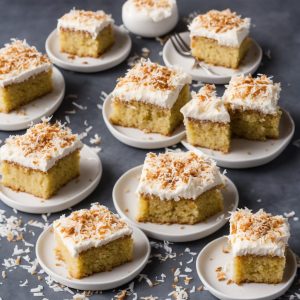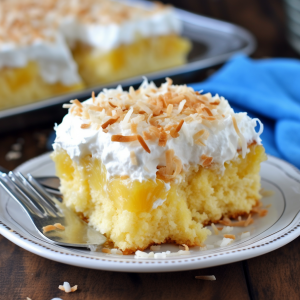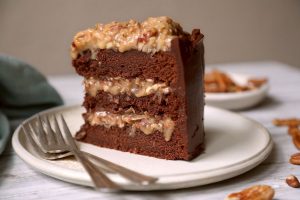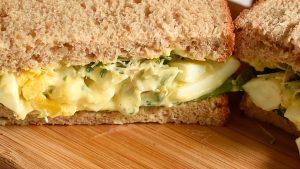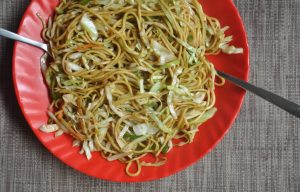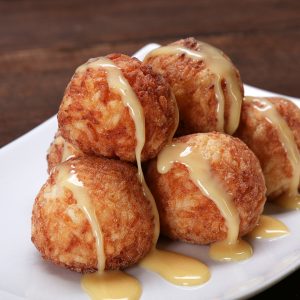The Ultimate Coconut Cake is a delightful dessert that embodies the tropical flavors of coconut. This cake is perfect for occasions where you want to impress with a homemade treat that's both delicious and beautifully presented.
The main ingredients for this recipe are cake flour, canned coconut milk, and coconut extract, which you may not typically have in your pantry. Cake flour provides a lighter, more delicate texture to the cake, setting it apart from those made with all-purpose flour. Canned coconut milk adds a rich, creamy texture and authentic coconut flavor to the cake. Coconut extract will enhance this flavor even more. These items can be found in the baking or international food aisle at most supermarkets.
Ingredients for the Ultimate Coconut Cake
Cake flour: A fine-textured, soft flour that results in a light and airy cake.
Baking powder: A leavening agent that helps the cake rise.
Salt: Balances out the sweetness and enhances the overall flavor.
Granulated sugar: Adds sweetness to the cake.
Unsalted butter: Gives the cake a rich flavor and moist texture.
Vegetable oil or canola oil: Keeps the cake moist and tender.
Unsweetened canned coconut milk: Gives the cake a rich, coconut flavor and creamy consistency.
Eggs: Work as a binding agent and contributes to the cake's structure.
Coconut extract: Enhances the coconut flavor in the cake.
Vanilla extract: Adds a depth of flavor.
Cream of tartar: Stabilizes the egg whites and helps them hold their shape once whipped.
Cream cheese: Creates a creamy, tangy frosting.
Powdered sugar: Sweetens the frosting and gives it a smooth texture.
Coconut: Adds a tropical touch and texture to the frosting.
One reader, Annamarie Partridge says:





This ultimate coconut cake recipe is a game-changer! The cake is moist and flavorful, and the coconut cream cheese frosting is to die for. It's a hit at every gathering, and I always get asked for the recipe. It's a must-try for all coconut lovers!
Techniques Required for Making the Ultimate Coconut Cake
How to prepare the cake batter: Combine the dry ingredients and wet ingredients separately, then fold in whipped egg whites to create a light and fluffy batter.
How to make the coconut cream cheese frosting: Beat together the cream cheese and butter until smooth, then add coconut extract and powdered sugar until the frosting is smooth and fluffy.
How to assemble the cake: Stack the cake layers with frosting in between, then frost the top and sides of the cake. Finally, sprinkle shredded coconut over the frosted cake.
How To Make The Best Ever Coconut Cake
Coconut overload! This fluffy coconut cake coated with coconut cream cheese frosting then finished with shredded coconuts on top.
Serves:
Ingredients
- 3cupscake flour
- 1tbspbaking powder
- ½tspsalt
- 2cupsgranulated sugar
- ¾cupunsalted butter,at room temperature
- ¼cupvegetable oil or canola oil
- 1⅓cupsunsweetened canned coconut milk,well shaken, at room temperature
- 2large eggs,at room temperature, yolks and whites separated
- 1tspcoconut extract
- ½tspvanilla extract
- 4large egg whites,at room temperature
- ⅛tspcream of tartar
For Coconut Cream Cheese Frosting:
- 12ozcream cheese,nearly at room temperature
- ¾cupunsalted butter,at room temperature
- 1tspcoconut extract
- 5cupspowdered sugar
- 1½cupscoconut,shredded
Instructions
Cake:
-
Preheat oven to 350 degrees F. Butter 3 9-inch round cake pans and line bottom of each with a round of parchment paper, butter parchment paper and set pans aside.
-
Sift cake flour into a large mixing bowl, then add baking powder and salt and whisk mixture.
-
In the bowl of an electric stand mixer, fitted with the paddle attachment, blend together granulated sugar, butter, and canola oil on medium speed until well combined. Scrape down the bowl.
-
Add in egg yolks one at a time and mix until combined after each addition (reserve 2 egg whites), then mix in coconut and vanilla extracts. Scrape down the bowl.
-
Add 1/3 of the flour mixture, then blend just until combined. Add half of the coconut milk and mix just until combined. Mix in another 1/3 of the flour mixture followed by remaining coconut milk. Finish by mixing in the last 1/3 of the flour mixture.
-
In a separate mixing bowl, using an electric hand mixer, whip 6 egg whites with cream of tartar on medium-high speed until stiff (but not dry) peaks form.
-
Using a rubber spatula, carefully fold 1/3 of the egg whites into cake batter at a time and fold just combined after each addition. Do not overmix.
-
Divide batter among prepared cake pans. Spread batter into an even layer and bake in the preheated oven for about 19 to 22 minutes until a toothpick inserted into the center of the cake comes out clean.
-
Allow to cool in cake pan for 5 to 10 minutes then run a knife along edges of cakes and invert each onto a wire rack to cool. Cool completely the cut tops to even as needed.
-
Stack the cakes, frosting in between each layer. Frost top and sides. Place cake on the stand over a rimmed baking sheet and sprinkle cake evenly with shredded coconut, pressing gently on sides to adhere.
-
Store in an airtight container in the refrigerator. Let rest at room temp until no longer cold before serving.
-
Coconut Cream Cheese Frosting:
-
In the bowl of an electric stand mixer fitted with the paddle attachment, whip butter with cream cheese until smooth and fluffy. Mix in coconut extract.
-
Add powdered sugar and whip on medium speed until smooth and fluffy. Chill as needed if frosting seems runny.
Nutrition
- Calories: 670.35kcal
- Fat: 35.47g
- Saturated Fat: 21.34g
- Trans Fat: 0.73g
- Monounsaturated Fat: 9.35g
- Polyunsaturated Fat: 1.84g
- Carbohydrates: 85.38g
- Fiber: 1.13g
- Sugar: 62.98g
- Protein: 5.87g
- Cholesterol: 92.39mg
- Sodium: 248.79mg
- Calcium: 102.29mg
- Potassium: 157.74mg
- Iron: 3.02mg
- Vitamin A: 233.38µg
- Vitamin C: 0.44mg
Technique Tip for Making the Perfect Coconut Cake
When folding the egg whites into the cake batter, ensure to do it gently and slowly. This helps to maintain the airiness of the whipped egg whites, which contributes to the light and fluffy texture of the cake. Overmixing can deflate the egg whites, resulting in a denser cake. So, take your time and fold in small portions for the best results.
Time-Saving Tips for Making Coconut Cake
Prep ahead: Prepare the cake layers and frosting a day in advance to save time on the day of baking.
Use pre-made frosting: If you're short on time, consider using store-bought coconut frosting instead of making it from scratch.
Organize ingredients: Gather and measure all the ingredients before starting to streamline the baking process.
Bake in advance: Bake the cake layers ahead of time and freeze them until you're ready to assemble the cake.
Efficient assembly: Have all your tools and equipment ready before assembling the cake to work more efficiently.
Quick clean-up: Clean as you go to minimize the mess and make the post-baking cleanup faster.
Streamlined decoration: Opt for simple cake decorations to save time, such as using shredded coconut for a quick and elegant finish.
Substitute Ingredients For The Best Ever Coconut Cake Recipe
cake flour - Substitute with all-purpose flour: All-purpose flour can be used as a substitute for cake flour by adding a small amount of cornstarch to mimic the lower protein content of cake flour.
unsalted butter - Substitute with margarine: Margarine can be used as a substitute for unsalted butter in baking. However, it may alter the flavor slightly.
coconut milk - Substitute with whole milk: Whole milk can be used as a substitute for coconut milk, but it will not have the same coconut flavor.
coconut extract - Substitute with vanilla extract: Vanilla extract can be used as a substitute for coconut extract, although it will not provide the same coconut flavor.
cream cheese - Substitute with Greek yogurt: Greek yogurt can be used as a substitute for cream cheese in frosting, providing a tangy flavor and creamy texture.
powdered sugar - Substitute with granulated sugar: Granulated sugar can be used as a substitute for powdered sugar by blending it to a fine powder in a food processor.
Best Way to Present the Ultimate Coconut Cake
Elevate the cake layers: Carefully stack the cake layers, ensuring they are perfectly aligned for a visually appealing presentation.
Artfully apply the frosting: Use a palette knife to expertly spread the coconut cream cheese frosting between the layers and on the top and sides of the cake, creating a smooth and elegant finish.
Garnish with precision: Sprinkle the shredded coconut over the top of the cake in a controlled and deliberate manner, ensuring even coverage and a polished appearance.
Incorporate edible flowers: Adorn the cake with delicate, edible flowers such as orchids or pansies to add a touch of sophistication and a pop of color to the presentation.
Utilize symmetry: Arrange the cake slices on individual serving plates with precision, ensuring each slice is presented in a visually balanced and harmonious manner.
Accent with fresh fruit: Add a final touch by placing a few fresh coconut slices or berries strategically around the plated cake slices, enhancing the overall visual appeal and providing a hint of freshness.
Essential Tools for Making Coconut Cake
- Oven: An essential appliance for baking the cake at the specified temperature.
- 9-inch round cake pans: Used to bake the cake layers.
- Electric stand mixer: Used to blend the cake batter and whip the egg whites.
- Paddle attachment: An attachment for the stand mixer, used for blending the cake batter.
- Electric hand mixer: Used to whip the egg whites until stiff peaks form.
- Rubber spatula: Used to fold the whipped egg whites into the cake batter.
- Wire rack: Used to cool the baked cake layers.
- Rimmed baking sheet: Placed under the cake stand to catch excess shredded coconut while decorating.
How To Store and Freeze Coconut Cake
- To store the coconut cake, place it in an airtight container or wrap it tightly with plastic wrap. It can be kept in the refrigerator for up to 5 days.
- For best results, allow the cake to come to room temperature before serving, as the cream cheese frosting will be more flavorful and easier to slice when softened.
- If you want to freeze the cake, it's best to do so before adding the shredded coconut topping. Wrap the frosted cake tightly in plastic wrap, followed by a layer of aluminum foil. Label the package with the date and store it in the freezer for up to 2 months.
- To thaw the frozen cake, remove it from the freezer and let it defrost in the refrigerator overnight. Once thawed, add the shredded coconut topping and allow the cake to come to room temperature before serving.
- If you have leftover slices of cake, wrap each slice individually in plastic wrap and store them in an airtight container in the refrigerator for up to 3 days, or in the freezer for up to 1 month.
How To Reheat Coconut Cake Leftovers
The best way to reheat leftover coconut cake is to warm it up gently in the oven. Preheat your oven to 300°F (150°C) and place the cake on a baking sheet lined with parchment paper. Cover the cake loosely with aluminum foil to prevent it from drying out. Bake for about 10-15 minutes, or until the cake is heated through and the frosting is soft and glossy.
Another option is to reheat individual slices of coconut cake in the microwave. Place a slice on a microwave-safe plate and heat it on medium power for 15-20 seconds at a time, until it reaches your desired temperature. Be careful not to overheat the cake, as it can cause the cream cheese frosting to melt and become runny.
If you want to restore the texture of the cake and make it taste fresher, you can also try steaming it. Fill a pot with about an inch of water and bring it to a simmer. Place the cake slice on a heatproof plate and set it on top of the pot, making sure the plate doesn't touch the water. Cover the pot with a lid and steam the cake for 2-3 minutes, or until it's soft and moist.
For a quick and easy reheating method, you can also warm up a slice of coconut cake in a toaster oven. Set the toaster oven to 300°F (150°C) and place the cake slice on the rack. Toast for 2-3 minutes, or until the cake is heated through and the edges are slightly crispy.
If you want to enjoy your leftover coconut cake cold, simply take it out of the refrigerator and let it sit at room temperature for 10-15 minutes before serving. This will allow the butter and cream cheese in the frosting to soften and become more spreadable, making the cake easier to slice and eat.
Random Fact About Coconut Cake
Coconut cake is a popular dessert in the southern United States and is often served at special occasions such as weddings and birthdays.
Is Making Coconut Cake at Home Economical?
The cost-effectiveness of this coconut cake recipe is quite favorable for a household. The ingredients are fairly common and affordable, with the exception of coconut extract and cream cheese, which may be slightly pricier. However, the overall cost is reasonable, especially considering the delightful end result. The approximate cost for a household of 4 people would be around $20-$25, making it a budget-friendly treat. Rating: 9/10.
Is Coconut Cake Healthy or Unhealthy?
The ultimate coconut cake recipe is a decadent treat that, while delicious, is not particularly healthy. The cake is high in sugar, fat, and calories due to the generous amounts of butter, oil, and sugar used in the batter and frosting. The use of coconut milk and shredded coconut adds some nutritional value in the form of healthy fats and fiber, but these benefits are overshadowed by the overall calorie and sugar content.
To make this recipe healthier, consider the following suggestions:
- Reduce the amount of sugar in the cake batter and frosting, or use a natural sweetener like coconut sugar or maple syrup
- Replace some of the butter with Greek yogurt or applesauce to lower the fat content
- Use whole wheat pastry flour instead of cake flour to increase the fiber content
- Opt for a lighter frosting, such as a whipped cream cheese frosting or a coconut milk-based glaze, to cut down on the butter and sugar
- Serve smaller portions and pair the cake with fresh fruit to balance out the richness and add more nutrients
Editor's Thoughts on This Coconut Cake Recipe
As a culinary expert, I find this coconut cake recipe to be a delightful combination of flavors and textures. The use of coconut milk and extract infuses the cake with a rich, tropical taste, while the coconut cream cheese frosting adds a luscious and creamy finish. The instructions are clear and detailed, ensuring that the cake turns out moist and tender. The addition of shredded coconut on top adds a lovely visual and textural element. Overall, this recipe promises to deliver a decadent and indulgent coconut cake that will surely impress anyone who tries it.
Enhance Your The Best Ever Coconut Cake Recipe with These Unique Side Dishes:
Alternative Recipes Similar to Coconut Cake
Suggested Appetizers and Main Courses to Serve with Coconut Cake
Why trust this The Best Ever Coconut Cake Recipe:
This ultimate coconut cake recipe is a tried and tested favorite among coconut lovers. The combination of coconut milk and coconut extract infuses the cake with a rich, tropical flavor. The use of cream cheese in the frosting adds a creamy and tangy element that perfectly complements the sweetness of the cake. With meticulous attention to detail in the instructions, this recipe ensures a moist, flavorful, and visually stunning coconut cake that will impress both bakers and dessert enthusiasts alike.
Was this page helpful?
Have your own special recipe to share? Submit Your Recipe Today!



